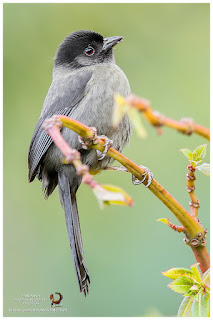Again we teamed up with
Advantage Tours Panama (
http://advantagepanama.com) on a half day tour around Chiriquí Highlands, joining a group from
New Jersey Audubon Society which was finishing their 10 days of birdwatching itinerary. We started the day at sunrise in the vicinity to Volcan Baru National Park close to the town of Guadalupe and los Quetzales trail. We traveled from David to meet our guides for the day, Guido Berguido and Luis Paz, and their birdwatching customers.
One of the most important shots of the day was this one. We finally had a clear and close shot of a Black-faced Solitaire (Myadestes melanomas) which was singing on an exposed perch while sallying occasionally to take berries. This has not been the first time we see this species eating these berries.
There was a couple of Volcano Hummingbirds (Selasphorus flammula) around but the light was very poor at the moment this guy was flying close. Therefore, we made a very noisy shot and decided it looked better in black and white. Later, this guy perched giving us a nice view of the gray-purple gorget, but we were not very fast to make a picture before it was flushed by a mountain gem hummingbird. This was not the first time we see this species at the location so we hope for a better shot at a near future tour.
While we were awaiting for the showcase of the day (of course the quetzals) we observed a lot of birds around the place, we can't even list them all but we had the opportunity to capture more and better shots of species that have been showed and described before on this blog:
Common Chlorospingus (Chlorospingus flavopectus)
Slaty Flowerpiercer (Diglossa plumbea)
Wilson's Warbler (Cardellina pusilla)
Yellow-thighed Finch (Pselliophorus tibialis), they were shy to show their bright yellow leggings.
Ruddy-capped Nightingale-thrush's (Catharus frantzii) binomial commemorates the German naturalist
Alexander von Frantzius. This species has
olive-brown upperparts, a
rufous crown and nape,
pale grey underparts, becoming whitish on the belly, and an
orange lower mandible. In Panama it's restricted to westernmost highlands and it's found in the undergrowth and ground of humid forests and second growth.
After a long wait the Resplendent Quetzals showed up, and the whole group was amazed by such beautiful birds. We had previous encounters with the species but we are always searching for "the perfect" picture so we didn't spare the opportunity and did our best effort disregarding the birds were not really close as the other birds pictured above.
Resplendent Quetzal (Pharomachrus mocinno) - female
The appearance of the female resplendent quetzal is duller and less dramatic. The crown, head, back, scapulars, wing coverts, rump, and uppertail coverts are iridescent, golden green. The crest feathers are less developed than the male. The uppertail coverts do not extend beyond the tip of the tail. Belly and sides mostly gray; undertail coverts red. The tail is black with the three outer rectrices on both sides barred in white and black. In general, the female quetzal differs from other trogons in its range by the larger size and the rich green coloration.
Resplendent Quetzal (Pharomachrus mocinno) - male
The resplendent quetzal male has iridescent or golden green upperparts, head, neck, and chest; the green may appear bluish in darker light. The lower breast, belly, and undertail coverts are bright red. The greater wing coverts are elongated. The feathers on the head form a crest, from the forecrown to the rear of the head. The uppertail coverts, also green, are greatly elongated beyond the tail. The coverts cross above the end of the tail.
After admiring the quetzals we went to Bambito to have an excellent meal courtesy of Advantage Tours and later on the way to David we stopped at middle elevations in the vicinity of Paraiso were Advantage Tours was scouting, we observed a lot more birds specially Fiery-billed Aracaris and Elegant Euphonias thanks to Mishael Rivera, a young guy that is initiating in birdwatching and placing feeders to attract some specialties.
We only had photo opportunities with a
Fiery-billed Aracari (Pteroglossus frantzii) a
toucan that breeds only on the Pacific slopes of southern Costa Rica and western Panama. As in the Ruddy-capped Nightingale-thrush above, the binomial commemorates the German naturalist Alexander von Frantzius.
A New Jersey Audubon's member was so grateful to Mishael, and recognising he needed a good pair of binoculars, that got him a pair of
Zeiss Terra bins. Also, Advantage Tours bought him a
Birds of Panama, A Field Guide book, both were delivered on a later date by Luis Paz.
Luis from Advantage Tours Panama handing over the birdwatcher's kit to Mishael Rivera
All in all, it was a short visit to Paraiso, and we had to travel to Boquete where we were going to meet one of our correspondents in order to travel the next day to Punta Burica, we also were planning to enjoy a couple of craft beers from
Boquete Brewing Company (our favourite place in Boquete) but it went out of hand when "a couple" turned into "an open bar". More on that in the next post...
More recently we visited Mishael's place scouting for pictures but that will be a matter of a future post. All we can say so far is that more time is required to be spent there, the area is amazing because the lowlands meet the highlands, resulting in an interesting mix of birds, and more importantly there are some species that are found on far places like Punta Burica (our next stop on this tour), and more commonly or easier to observe.





















Comments
Post a Comment